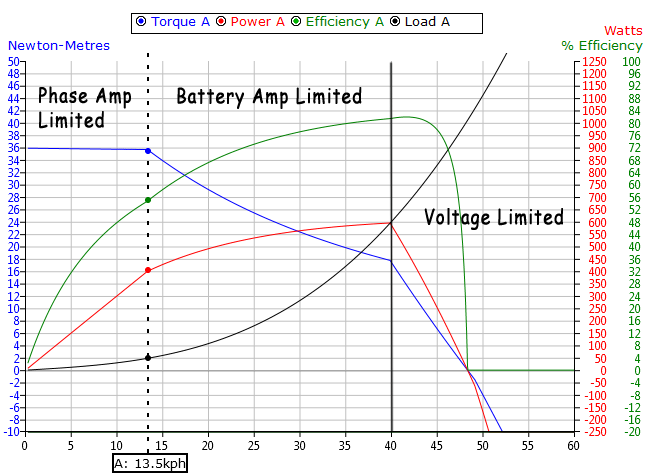Simulator
The simulator at https://ebikes.ca/tools/simulator.html is a very powerful tool if you know how to use it.
When you run it, you will be given a graph. Here is an annotated version of the graph it produces showing the 3 main sections of the graph:
In the first section, Phase Amp Limited, the motors max torque is limited by the controllers max phase amp output. Phase amps are higher then battery amps because a controller steps down voltage, trading volts for amps to get more torque. At low speed, a motors back EMF voltage is very low and it does not take much additional voltage to feed in the desired number of phase amps. Output power in this area is basically max torque * RPM and linearly increases with speed.
In the second section, Battery Amp Limited, the controllers can output full wattage to the motor at all times and the red output power line only changes due to changes in the motors efficiency at different RPMs. This line is dominated by your battery amp limit of your controller. Ie your max power. With higher max battery amps (ie power), the phase amp limited zone will actually continue to the right further on the graph, and this whole area will end up with higher power output.
In the third section, Voltage Limited, power falls because the voltage of the battery can no longer feed full power onto the motor, due to the motors back EMF and winding resistance. This area of the graph can be helped by using field weakening, although the simulator does not have the ability to simulate field weakening. Power output falls very linearly in this area as current to the motor falls. You generally want max speed to occur at the very start of this area for ideal overall efficiency if not using field weakening. Increasing your batteries voltage will make this section of the graph occur at higher speeds.
Tips:
If you are looking to simulate the common generic 1KW hub motors, you should select the 9C 2706 or 9C 2705. If you don't know what motor your using, it doesn't change a whole lot except 'overheat in' times. Speeds and ranges for most common controller/battery configurations will be rather similar regardless what motor you pick. (+- 10% typically)
Remember to set 'human power' to 0W if you are not planning on pedaling.
The battery AH * Voltage influences range. Battery voltage influences when the voltage limited area of the graph starts. Motor choice influences 'overheat in' and 'final temp' the most and when the voltage limited area of the graph starts.
